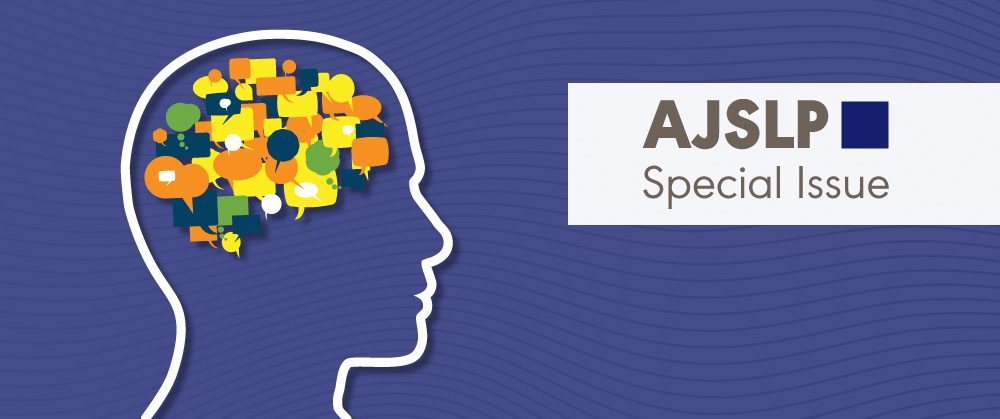Every year, more than 100,000 Americans acquire aphasia, a condition in which a person has difficulty speaking or writing—or understanding spoken or written information. ASHA members play a key role in screening for, assessing, and treating this population as well as educating the public on prevention methods.
The Clinical Aphasiology Conference (CAC) gives experts an opportunity to gather and share their latest discoveries in the clinical treatment of aphasia. Guest Editor Michael de Riesthal has developed a special issue of the American Journal of Speech-Language Pathology (AJSLP) featuring 14 articles based on research presented at the 51st CAC. Check out highlights from the special issue below!
Aphasia Therapies
The issue opens with an article by Raymer and Roitsch using systematic reviews and meta-analyses to show the effectiveness of constraint-induced language therapy for aphasia. Later, King et al. compare the effects of two treatment protocols for acquired apraxia of speech: Sound Production Treatment and Metrical Pacing Therapy.
Hinckley and Sanchez studied how speech-language pathologists (SLPs) determine which aphasia treatment to use. Repetition priming has led to improved naming ability in anomia; Silkes investigated whether this correlation was the result of deeper-level semantic processing or simply learned correspondences between words and pictures. Elsewhere in the special issue, Fisher and colleagues showed that an objective clustering method could be used to determine verb fluency performance in individuals with Alzheimer’s dementia.
Telehealth in Aphasia
Three articles focused on remote treatment for aphasia. Dunne and colleagues studied whether the changes in language impairment and quality of life associated with group conversation treatment could be replicated in a virtual group.
Kallhoff et al. showed that Combined Aphasia and Apraxia of Speech Treatment (CAAST) could be administered remotely. Later, Kallhoff and another team of co-authors compared sound production treatment delivered remotely and in person.
More Highlights From the CAC
Park and colleagues examined verb production of people with nonfluent aphasia, finding that although some verb usage was preserved, people with nonfluent aphasia used fewer verbs that have less specific meanings—verbs such as “do” or “make.” Scadden Nelson et al. later found that people with aphasia were more affected by background noise when completing a story retell task.
Slow speech rate and abnormal prosody are used to differentiate aphasia from apraxia of speech; Haley and colleagues provide SLPs with an appropriate word syllable duration cutoff to help with assessments. Then, Azios et al. advocated for the use of conversational analysis to study texting exchanges in people with aphasia.
Elsewhere, Harmon and colleagues sought to determine a link between (a) physiological attentiveness and arousal and (b) word retrieval, showing that helping these patients fully engage during therapy can result in more positive outcomes. MacWhinney and Fromm described the collaborative commentary system, a feature that allows researchers, instructors, students, and clinicians to comment on the TalkBank clinical databases, including AphasiaBank.
Helping People With Aphasia
We hope that this special issue provided you with insight, information, and inspiration to help your clients with aphasia and their families. Check out some highlights of our previous coverage of the CAC below!
Highlights From the 50th Clinical Aphasiology Conference
The Latest on Clinical Aphasiology in AJSLP
AJSLP Special Issue Highlights the 49th Clinical Aphasiology Conference
Explore the Special Issue
Azios, J. H., Lee, J. B., & Cherney, L. R. (2023). Conversation analysis of texting exchanges in aphasia. American Journal of Speech-Language Pathology, 32(5S), 2512–2527. https://doi.org/10.1044/2023_AJSLP-22-00303
Dunne, M., Hoover, E., & DeDe, G. (2023). Efficacy of aphasia group conversation treatment via telepractice on language and patient-reported outcome measures. American Journal of Speech-Language Pathology, 32(5S), 2565–2579. https://doi.org/10.1044/2023_AJSLP-22-00306
Fisher, M., N., Casenhiser, D. M., & Paek, E. J. (2023). Objective and subjective clustering methods for verb fluency responses from individuals with Alzheimer’s dementia and cognitively healthy older adults. American Journal of Speech-Language Pathology, 32(5S), 2589–2601. https://doi.org/10.1044/2023_AJSLP-22-00290
Haley, K. L., Jacks, A., Kim, S., Rodriguez, M., & Johnson, L. P. (2023). Normative values for word syllable duration with interpretation in a large sample of stroke survivors with aphasia. American Journal of Speech-Language Pathology, 32(5S), 2480–2492. https://doi.org/10.1044/2023_AJSLP-22-00300
Harmon, T. G., Johnson, A., Ward, V., & Nissen, S. L. (2023). Physiological arousal, attentiveness, emotion, and word retrieval in aphasia: Effects and relationships. American Journal of Speech-Language Pathology, 32(5S), 2554–2564. https://doi.org/10.1044/2023_AJSLP-22-00305
Hinckley, J., & Sanchez, L. (2023). Treatment time and treatment selection in aphasia: A preliminary study using vignettes. American Journal of Speech-Language Pathology, 32(5S), 2430–2443. https://doi.org/10.1044/2023_AJSLP-22-00294
Kallhoff, L., Mauszycki, S., Rose, B., & Wambaugh, J. (2023). The impact of telehealth on the efficacy of sound production treatment. American Journal of Speech-Language Pathology, 32(5S), 2461–2479. https://doi.org/10.1044/2023_AJSLP-22-00301
Kallhoff, L., Moua, P. T., Salomon, D., & Wambaugh, J. (2023). The outcomes of remote administration of combined aphasia and apraxia of speech treatment: A single-subject experimental design study. American Journal of Speech-Language Pathology, 32(5S), 2402–2417. https://doi.org/10.1044/2023_AJSLP-22-00297
King, C. R., Wambaugh, J. L., & Maas, E. (2023). A comparison of sound production treatment and metrical pacing therapy for apraxia of speech: A single-case experimental design. American Journal of Speech-Language Pathology, 32(5S), 2493–2511. https://doi.org/10.1044/2023_AJSLP-22-00302
MacWhinney, B., & Fromm, D. (2023). Collaborative commentary for understanding communication disorders. American Journal of Speech-Language Pathology, 32(5S), 2580–2588. https://doi.org/10.1044/2023_AJSLP-22-00385
Park, H., Obermeyer, J., Kornisch, M., Hall, J., & Ontario, C. (2023). Semantic aspects of verb production in various discourse tasks in people with nonfluent aphasia. American Journal of Speech-Language Pathology, 32(5S), 2418–2429. https://doi.org/10.1044/2023_AJSLP-22-00293
Raymer, A. M., & Roitsch, J. (2023). Effectiveness of constraint-induced language therapy for aphasia: Evidence from systematic reviews and meta-analyses. American Journal of Speech-Language Pathology, 32(5S), 2393–2401. https://doi.org/10.1044/2022_AJSLP-22-00248
Scadden Nelson, B., Harmon, T. G., Dromey, C., & Dixon Clawson, K. (2023). Telling stories in noise: The impact of background noises on spoken language for people with aphasia. American Journal of Speech-Language Pathology, 32(5S), 2444–2460. https://doi.org/10.1044/2023_AJSLP-22-00299
Silkes, J. P. (2023). Repetition priming treatment for anomia: Effects of single- and multiple-exemplar protocols. American Journal of Speech-Language Pathology, 32(5S), 2528–2553. https://doi.org/10.1044/2023_AJSLP-22-00310









